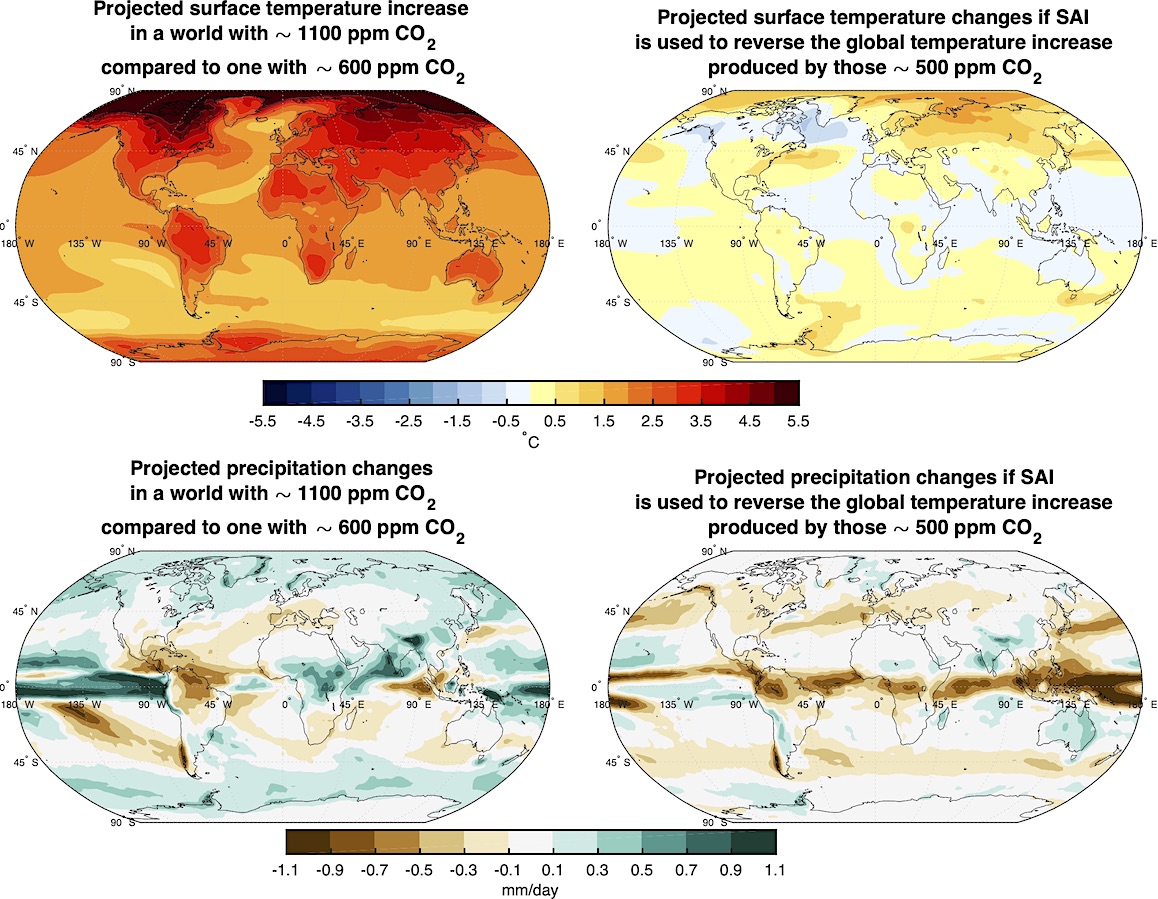About The Working Group

Climate change and associated global warming is caused by humans (IPCC 2013). The solution is to stop greenhouse gas emissions by eliminating dependence on fossil fuels (IPCC 2013, 2014).
Geoengineering, also known as climate intervention, is a set of proposed activities deliberately designed to counter the impacts of environmental change resulting from global warming. Geoengineering is under consideration as a temporary strategy that may help forestall the worst impacts of climate change as emissions reductions occur. It has received increasing attention in the face of failure to limit the inputs of greenhouse gases to the atmosphere (NASEM 2021). However, geoengineering alone will not remove all the impacts of anthropogenic climate change and should not be considered a solution. Emissions must stop for Earth’s temperature to stay within 1.5°C above pre-industrial levels.
Geoengineering is highly controversial. Nevertheless, many schemes for geoengineering have been proposed: these are usually divided between activities aimed at reducing the amount of carbon dioxide in the atmosphere (Carbon Dioxide Removal, CDR) and activities aimed at partially reducing the amount of incoming solar radiation at the surface by increasing the albedo (reflectivity) of the Earth-atmosphere system in order to temporarily cool the planet (Solar Radiation Modification, SRM). Reducing Earth’s temperature with SRM could involve injecting sulfate precursors in the stratosphere (like volcanoes do) or increasing the condensation nuclei in the marine boundary layer (like ship tracks do). This geoengineering option presents both known and unknown risks to the natural living world. Yet almost nothing is known about the potential impacts of implementation, continuation, or termination on natural systems, their functions, and their biodiversity.
Some climate intervention schemes have been extensively studied using complex Earth System Models. Earth System Models have their own uncertainty, and they are often run at spatial and temporal resolutions too coarse to align with most ecological systems. As a result, there is high uncertainty about the potential impacts of geoengineering.

The goal of the Climate Intervention Biology Working Group is to identify knowledge gaps and develop a research agenda to understand and predict the impacts and risks to biodiversity and functioning of natural systems, if solar radiation modification occurs in the future. Members will provide information to inform policy and public discussion, provide knowledge to incorporate into teaching and outreach, and engage a diverse audience in discussions on the response of living systems to solar radiation modification geoengineering.
This working group does not endorse or advocate either testing or actual implementation of geoengineering.
Relevant Links:
- Geoengineering Model Intercomparison Project - GeoMIP
- Stratospheric Aerosol Geoengineering Large Ensemble Project - GLENS
- Rutgers Impact Studies of Climate Intervention (RISCI) lab
- NCAR Community Climate Intervention Strategies (CCIS)
- Gordon Conference on Climate Engineering
References
Hoegh-Guldberg, O., et al. 2018. Impacts of 1.5°C of Global Warming on Natural and Human Systems. Page 138 Global Warming of 1.5°C. An IPCC Special Report on the impacts of global warming of 1.5°C above pre-industrial levels and related global greenhouse gas emission pathways, in the context of strengthening the global response to the threat of climate change, sustainable development, and efforts to eradicate poverty. Ch. 3. World Meteorological Organization, Geneva. https://www.ipcc.ch/sr15/
National Academies of Sciences, Engineering, and Medicine (NASEM). 2021. Reflecting Sunlight: Recommendations for Solar Geoengineering Research and Research Governance. The National Academies Press, Washington, DC. DOI:10.17226/25762. https://www.nationalacademies.org/our-work/developing-a-research-agenda-and-research-governance-approaches-for-climate-intervention-strategies-that-reflect-sunlight-to-cool-earth
IPCC, 2013: Climate Change 2013: The Physical Science Basis. Contribution of Working Group I to the Fifth Assessment Report of the Intergovernmental Panel on Climate Change. [Stocker, T.F., D. Qin, G.-K. Plattner, M. Tignor, S.K. Allen, J. Boschung, A. Nauels, Y. Xia, V. Bex and P.M. Midgley (eds.)]. Cambridge University Press, Cambridge, United Kingdom and New York, NY, USA, 1535 pp. https://www.ipcc.ch/report/ar5/wg1/
IPCC, 2014: Climate Change 2014: Mitigation of Climate Change. Contribution of Working Group III to the Fifth Assessment Report of the Intergovernmental Panel on Climate Change [Edenhofer, O., R. Pichs-Madruga, Y. Sokona, E. Farahani, S. Kadner, K. Seyboth, A. Adler, I. Baum, S. Brunner, P. Eickemeier, B. Kriemann, J. Savolainen, S. Schlömer, C. von Stechow, T. Zwickel and J.C. Minx (eds.)]. Cambridge University Press, Cambridge, United Kingdom and New York, NY, USA. https://www.ipcc.ch/report/ar5/wg3/
Tilmes, S., D.E. MacMartin, J.T.M. Lenaerts, L. van Kampenhout, L. Muntjewerf, L. Xia, C.S. Harrison, K.M. Krumhardt , M.J. Mills, B. Kravitz, and A. Robock. 2020. Reaching 1.5oC and 2.0oC global surface temperature targets using stratospheric aerosol geoengineering. Earth Systems Dynamics 11:579–601, https://doi.org/10.5194/esd-11-579-2020
Visioni, D., Slessarev, E., MacMartin, D., Mahowald, N. M., Goodale, C. L., and Xia,L. (2020), “What goes up must come down: impacts of deposition in a sulfate geoengineering scenario”, Environmental Research Letters, 15(9), https://iopscience.iop.org/article/10.1088/1748-9326/ab94eb
Visioni, D., MacMartin, D. G., Kravitz, B., Boucher, O., Jones, A., Lurton, T., Martine, M., Mills, M. J., Nabat, P., Niemeier, U., Séférian, R., and Tilmes, S.: Identifying the sources of uncertainty in climate model simulations of solar radiation modification with the G6sulfur and G6solar Geoengineering Model Intercomparison Project (GeoMIP) simulations, Atmos. Chem. Phys. Discuss. [preprint], https://doi.org/10.5194/acp-2021-133, in review, 2021
Zarnetske, P. L., J. Gurevitch, J. Franklin, P. M. Groffman, C. S. Harrison, J. J. Hellmann, F. M. Hoffman, S. Kothari, A. Robock, S. Tilmes, D. Visioni, J. Wu, L. Xia, and C.-E. Yang. 2021. Potential ecological impacts of climate intervention by reflecting sunlight to cool Earth. Proceedings of the National Academy of Sciences 118. DOI:10.1073/pnas.1921854118. https://www.pnas.org/content/118/15/e1921854118